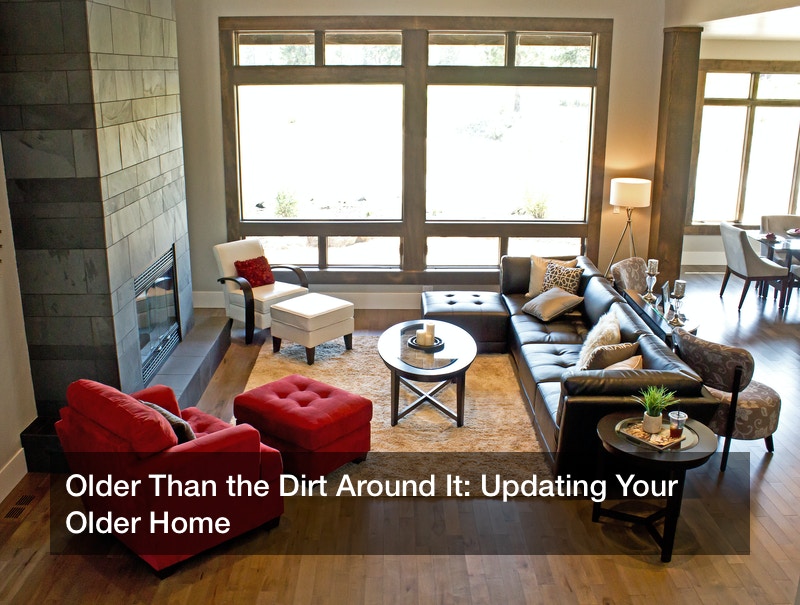
It’s certainly wonderful to be a property owner. Not only do you have full control over your home and the surrounding land, but you get to enjoy the peace and solitude that comes with it. Many people aspire to be homeowners, but are afraid of the maintenance involved in keeping a dwelling space habitable. From house siding to installing a kitchen sink, just thinking about repairs and maintenance gets folks flustered. Some of these worries are legitimate, while others are less than sensible (especially if your home is brand new).
If you buy an older or historic property, however, some of these concerns are more legitimate. The problems with older homes are wide and varied, but all are solvable. Even if the solution ends up being “gut and restore” rather than fix, that still ends up being a better action than letting a once habitable dwelling turn to nothing. After all, what is the point of owning a home if one does not intend to live in it or utilize it in some way?
Giving your home a modern feel, look and usage can provide you a whole host of positive benefits that are easy to imagine. One of these is surely peace of mind, but others have been documented. In fact, updating your home can do more than just improve the resale value or give you a warm fuzzy feeling inside: it may actually reap tangible benefits that translate into life changes. According to Houzz, approximately 33% of property owners say they change to a healthier lifestyle after remodeling their kitchen. It may be more expensive than a gym membership, but perhaps the positive effects are more long-lasting when you can make your own meals from scratch.
In this article we’ll discuss easy, but simple ways to update your older home and modernize it for maximum enjoyment. It may seem like more of a journey than a destination in navigating the problems with older homes, but such is the nature of ongoing maintenance when it comes to property. Things break, wood flooring needs to be varnished, and electrical outlets replaced. But rest assured that with the right budgeting, time frame, and willpower anybody can achieve the transformation of their house into a modern marvel.
From the Ground Up: Starting With the Foundation
It may not seem obvious when glancing around your house for ways to modernize and improve, but anything you do eventually has to come from the ground up. As a homeowner, this means making sure that the foundation of your house is still in good working order and there are no cracks, leaks, or serious issues present. One of the problems with older homes is that their foundation may have been built with inadequate materials, or at a building standard that is outdated or illegal now. You’ll want to find an accredited and reputable home inspector or contractor to find this out for you, because the consequences can be high. You may want to have two opinions present, and do some research on how your home’s foundation (whenever it was built) is different than ones being built today.

If your home is still standing, it is more than likely still structurally sound and not in need of immediate worry. But eventually, foundation problems may become an issue, hence the inspection and foresight. Common signs that your foundation is shifting, cracked, or becoming unstable are numerous. If you notice exterior cracks to your home, uneven floors or windows, rotten wood, or tiles cracks than you should be concerned. If the foundation of your house decides to go in one fell swoop, it will simply take everything else with it. It is simply one of the problems with older homes, therefore it is worth your time to invest in its inspection, maintenance and care.
Put a Roof On It (Or Simply Repair the One You’ve Got)
You could own the nicest house in the world, where the walls are covered in gold and there’s always gummy worms next to the beds for easy snacking, but if it doesn’t have a roof (or you need to repair roof leaks) then it will deteriorate quickly. It is an essential part of your home for very good reasons. A roof is like the “hat” or “lid” of a home, and without it, your property is exposed to the elements in all sorts of ways. The classic example is rain leaking through your roof is one of many, and none of them are worth gaining personal experience in. A simple search for photos and stories about people’s roofs being damaged or destroyed will avail your curiosity without having to seek it out yourself.
One of the problems with older homes is that they tend to have older roofs that are nearing replacement age. Roof replacements may not be cheap, but the alternative is almost always more expensive. Ask anyone who’s ever had to call water damage cleanup experts after a hurricane or bad storm put holes in their roof. Aside from water causing physical damage, it can many times lead to mold growth and pest infestations as well, because it creates a unique environment.
It’s Got to Go Somewhere: Septic and Water Systems
When you turn on the water faucet or flush the toilet, it just seems to work. Most of us don’t tend to question where the water comes from or where it goes because it’s always been there. But eventually, through lack or maintenance or no fault of your own, it won’t be. Whether this means you need to call a plumber or schedule a whole house copper re-piping will depend on what an expert says, but pipes and the water that flows through them need attention.
Of the numerous problems with older homes, water issues tend to make the top of the list, but not in the cleanest way. Water can come out of your tap, filtered fridge, or shower, but it can also come out of your toilet. Sewer replacements are never on anybody’s “fun list” for a day, but many times are necessary to keep your bathrooms functioning and house from flooding. Older toilet technology not only uses more water per flush, but many have a wax seal on the bottom that can loosen with age or use. Newer toilets use plastic or other materials that are less prone to degrade, but if you still have an older wax toilet you will want to check on it for signs of leaking or too much wear.
While you’re inspecting your water system, this is the perfect time to install filters in various areas for drinking or other purposes. If you have “hard water” and would like a nicer shower, you can have an in-line water filter installed that “softens” the water for a more pleasant bathing experience. Similarly, carbon-based drinking water filters can be installed in-line or through a dispenser with the help of an experienced plumber. You can drink amazing water that tastes like the premium brands if you’re only willing to put in the effort to install a great filter.
Appliances, Shared Spaces, and More
Appliances define a home in many ways: a laundry room that doesn’t feature a washer becomes a pointless space, as well as a kitchen without a sink. The appliances and utilities within different spaces of a house define its use and how the residents live. Arranged correctly and maintained, these spaces can be used as intended (like an oven in a kitchen). While many appliances, especially vintage ones, were manufactured to last a long time, eventually all objects break down and need replacement. One of the problems with older homes is that they tend to have old appliances.

Appliances aren’t just stand-alone objects like blenders or coffee makers, they include utilities that are built into the walls of the house such as microwaves/ovens, range tops, air conditioners, and even televisions. At the time these appliances were put in, they were standard technology and probably functioned well. But even in as little as five years time appliances can become extremely outdated, unfashionable, or just break down. Therefore it’s worth it to take a look around shared spaces like your kitchen, living room, and main hallways to try and determine whether practical updates will benefit these spaces as intended. Before you grow tired of your WiFi air conditioner and call a luxury contractor, differentiate between “want” and “need.”
If you’re looking for interesting appliances and tools that help you do more with less, consider investing in some “smart” appliances that work over your home’s internet connection. Instead of your stubborn old thermostat acting up and causing you headaches when you revamp your residential HVAC system you can invest in “smart” thermostats that automatically adjust the temperature according to trends, or from an app on your smartphone. In a similar vein, they make “smart” refrigerators and coffee makers, allowing you the freedom to monitor and control your home even when you’re not physically present. What’s more modern than that? It’s like living in the future.
Floors, Tiles and Everything In Between
One of the biggest problems with older homes is their flooring. Not only can it be completely out of style and gaudy, but it more than likely has had years of wear and tear on it from all sorts of different weights, shoes, materials, and conditions. Even a nice wooden floor can only stand so much abuse before it will need repairs or refinishing. Some homeowners never put down “nice” floors to begin with, opting for laminate or vinyl flooring which can be removed easily and at low cost.
Some homeowners get interested in tile, because of the practical utility of it and the many artistic options it can inspire. If you’re wondering where to get amazing tile, don’t worry. Most contractors that provide drywall services and painting will also be proficient at tiling, so it’s worth asking about if you get the chance. The price will obviously increase depending on quality and craftsmanship, but the benefit of tile is its true durability. Archaeological sites in Italy and Greece still reveal ancient tiled rooms, meaning that with the right materials and mortar the tiles in your house could outlast you!

Carpet has had varying degrees of popularity in homes, dependent on the area and year, but still has utility. It is not usually one of the problems with older homes unless it is hiding mold, mildew, or dust mites somewhere. If you need to create a softer space to fall down in or play with little ones, carpet will never go out of style and will actually be quite valuable. And while stains may seem like a downside, carpet is so easy to rip up and replace that it may as well be effortless. Putting wall-to-wall carpet in a room can be done in an hour by experienced professionals, and there are even many advanced “stain-proof” alternative material carpets on the market nowadays.
From an Old Hazard to a Modern Beauty
The problems with older homes may be wide and varied, but you’ve managed to fix most of yours. Not only have you been able to get rid of pests, molds, and outdated wallpaper, but you’ve probably gained a new appreciation for the work of maintaining and modernizing a home. Perhaps some things were easier than you thought while others caused sleepless nights and a whole bunch of fidgeting, but you got through it. Hopefully, the satisfaction about upgrading your home and improving its utility has done more for you that simply be giddy about its future retail value. Perhaps it’s even inspired you to give back some of this knowledge.
Now that you’re the proud owner of a more modern, updated home, you’ll probably be more incentivized to stay updated once you see the benefits. But other than complaining about the problems with older homes or cruising internet message boards for tips, what are some practical ways to stay updated with this knowledge? Many would be surprised at the resources available out in the world now, especially with the internet enabling searches to go far and wide.
One would be to subscribe to a magazine or newsletter that lists current building methods or architectural trends. Something that is halfway between “informative” and “look at what the rich/famous put in their homes” for good measure. These will not only point out problems with older homes (usually through product advertisements or renovations sections), but they might inspire you to be proactive with updating/repairing current things in your home before they become an issue.

Another way to stay updated on current building trends and home improvements is by participating in home building itself. This doesn’t mean that you have to become a contractor or work on a construction site, but you can learn a lot by volunteering for home builds through various organizations in which you can complete many different home tasks with others. In this way, you get to see how homes are built now and what materials are used efficiently. Through seeing many points of view and always learning, you’ll be able to grow onward and upward into the future as property owner.



